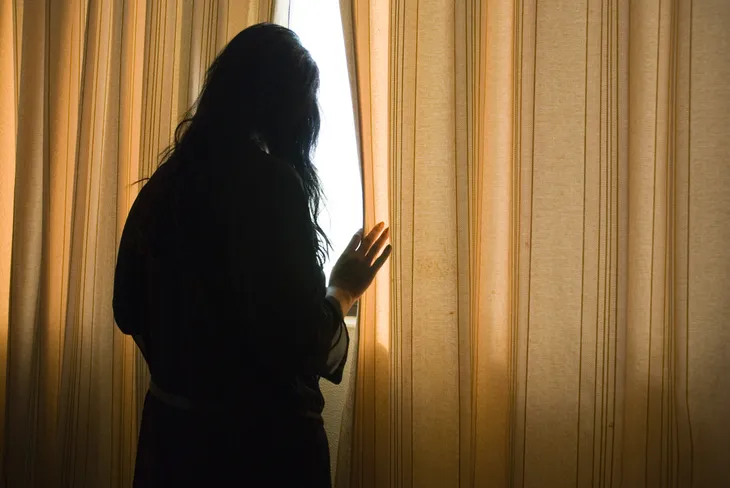Everyone is a little afraid of something – whether they admit it or not. However, not being a fan of public speaking and going into panic mode just thinking about it are two very different things, and a lot of people suffer from these types of phobias.
According to VeryWell.com, phobias are the most common mental disorder in the U.S., and they affect more women than men. Let’s dare to take a closer look at seven of the most common specific phobias gripping Americans…
1. Arachnophobia
A relatively high portion of all arachnophobia sufferers – 30.5-percent of them – live in the U.S. alone, according to FearOf.net. “It is one of the most common animal phobias around the world,” adds the source.
The site explains that it’s not just the creepy-crawliness of spiders that puts people into a panic – it is probably tied to evolution, meaning that we know deep down through human experience that spiders can be deadly, and we react accordingly. “Arachnophobes however tend to go to extreme lengths to ensure that their surroundings are free from spiders, often causing themselves a great deal of embarrassment,” it adds.
2. Social Phobia
This affects perhaps more people than you might realize – and it pertains to the fear of social interactions, which occur every day. However, many people tend to avoid unnecessary social situations because they fear the embarrassment of showing physical symptoms of the phobia or fearing they will say the wrong thing.
VeryWell.com explains that social phobias usually develop in adolescence, and that about 15-million American adults (6.8-percent of the adult population) suffer from social phobia, while 5.5-percent of the teenage population has the problem. On top of that, the source claims that while 30-percent of cases are considered severe, only about 40-percent of the cases are being treated.
3. Agoraphobia
Imagine being afraid to leave your house – well, that’s a reality for many Americans. Psychology Today says the word actually translates to “fear of the marketplace,” and relates to the fear of being trapped in a situation one can’t escape – so they stay home.
The article explains that about 1.7-percent of adolescents and adults suffer from agoraphobia, with women 2-times as likely to develop it as men. Onset can start as early as adolescence, and can even occur in childhood in some cases, it adds.
4. Acrophobia
If the thought of climbing a tall ladder makes you shudder, then you may have a case of acrophobia, more commonly referred to as a fear of heights. You wouldn’t be alone there; about 1 in 20-adults experiences this debilitating anxiety disorder, according to FearOf.net.
It’s not just ladders that make people panic – those with this specific phobia may also avoid fun things like a Ferris wheel or a roller coaster, and even skiing, adds the source. Driving on bridges can also be a big problem for those with acrophobia, as can ascending a tall building (which is a problem if you’re attending a work meeting or another professional function).
5. Claustrophobia
This is the fear of being in closed-in spaces, and can also be triggered by being in a crowded room with nowhere to escape (coupled with social anxiety for example, it can be very crippling). Sources notes claustrophobia is generally considered to be a symptom of an anxiety disorder, rather than it’s own specific disorder.
EverydayHealth.com explains that more women experience this one too, and that this phobia “may develop after a traumatic childhood event, such as being trapped in a closet”.
6. Aerophobia
The thought of flying may be freeing for some people – for others (about 6.5-percent of the world’s population), not so much. FearOf.net explains this fear is often tied to 2-previously mentioned phobias, namely agoraphobia and claustrophobia.
This fear of flying is so bad that it prevents many sufferers from ever boarding an aircraft, which can impact them professionally and limit their travel experiences, it adds. “The mere thought of an upcoming flight can cause intense distress in the sufferer,” notes the source, adding physical symptoms like nausea and panic attacks can follow.
7. Glossophobia
Chances are you will have to speak in public more than a few times in your life, whether it’s for school, work, or a formal function (like a wedding). However, for up to 75-percent of the population, having to step up to the podium to speak to a crowd is the stuff of nightmares, according to Glossophobia.com.
“Statistically, far more of us claim that we would prefer death to giving a speech,” notes the site, demonstrating how severe this fear is for many people. This can affect people who are obligated to perform in front of crowds, like musicians and actors, but also professionals making presentations, it adds. The source goes as far as explaining that some pilots shudder at the thought of having to address passengers via the sound system during flights.










